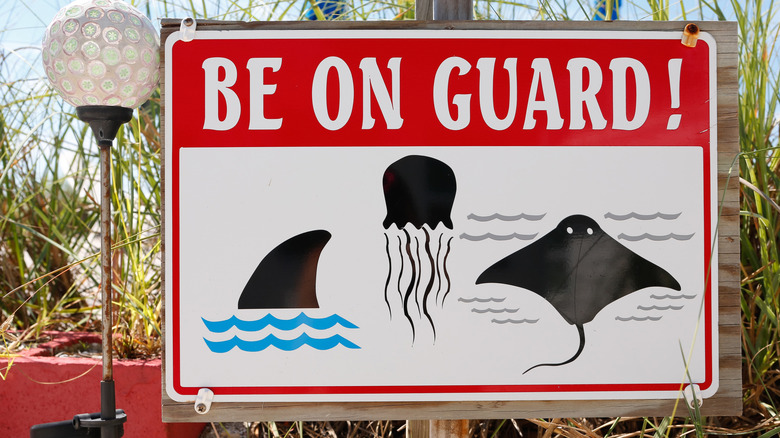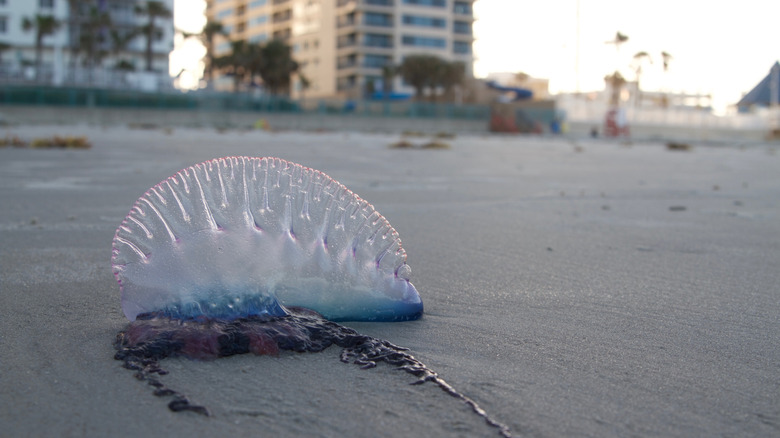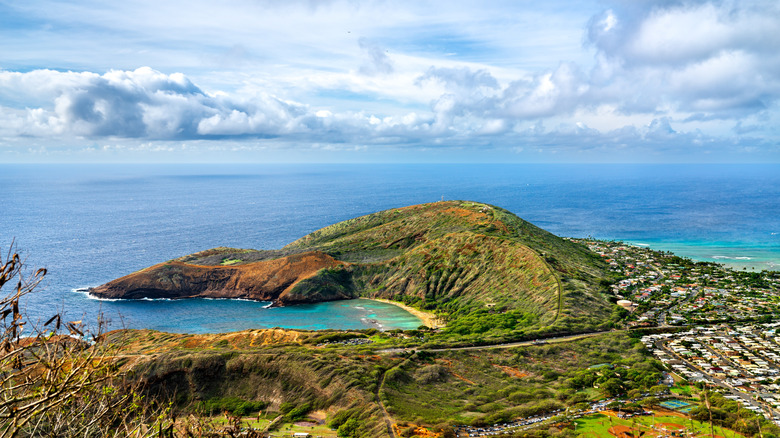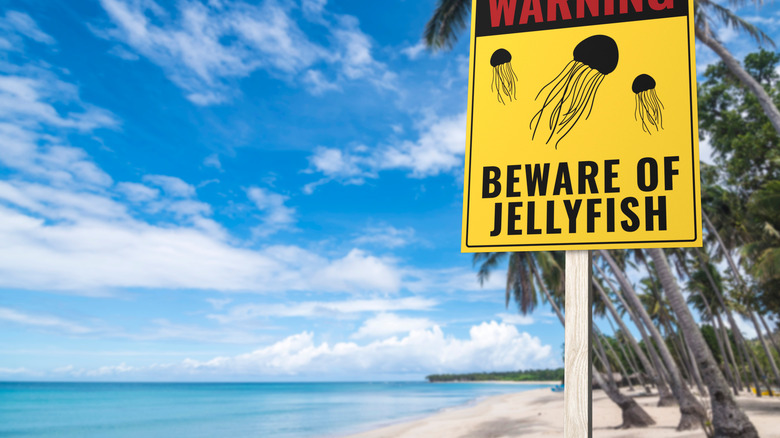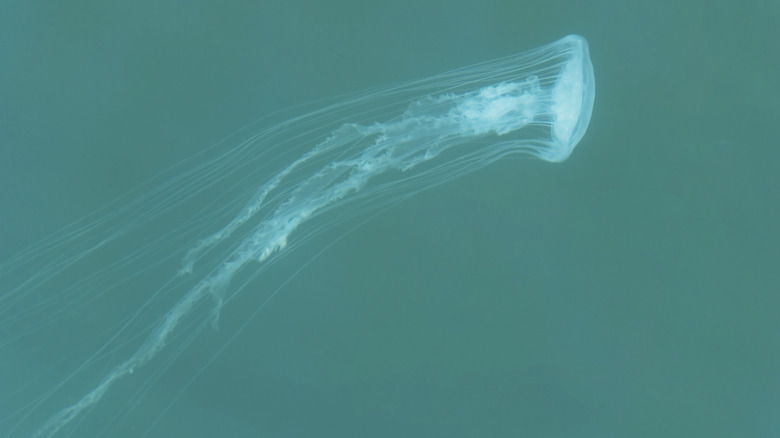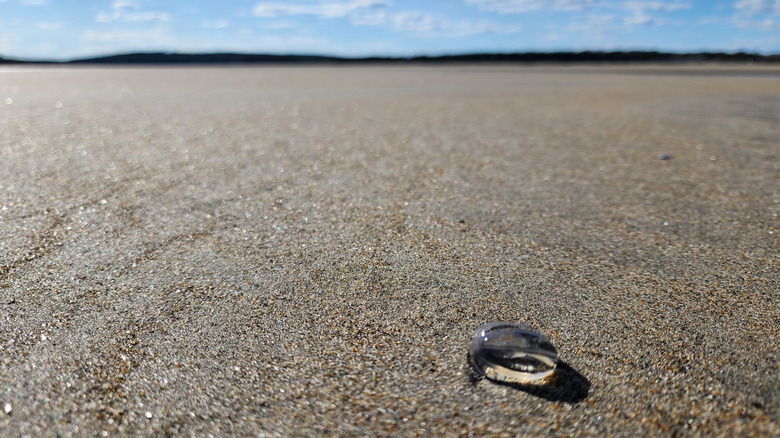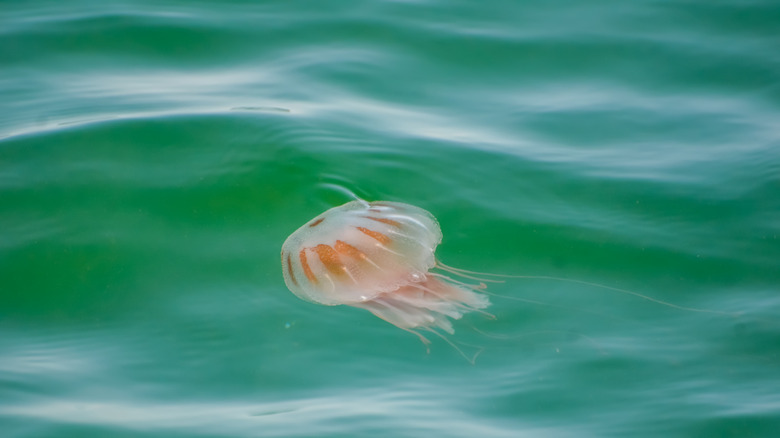Beaches Across America Where You're Most Likely To Get Stung By Jellyfish, According To Research
Nothing can mess up a day at the beach like a jellyfish sting. Jellyfish are common around the world, and these transparent creatures can be some of the most dangerous creatures you're likely to encounter on a beach vacation. Fortunately, most of the jellyfish along the U.S. coastline are not deadly, even if sometimes the sting is painful enough that you might feel (or wish) you were dying. However, if you show signs of an allergic reaction, very rare but possible, seek medical care immediately.
Jellyfish populations are traditionally cyclical, according to scientists, but populations have been showing growth in recent years. Scientists theorize that warming oceans have created more ideal conditions for jellyfish breeding and lifecycles, causing them to grow larger and reproduce faster. Human activity has also fueled jellyfish growth through overfishing, which reduces competition for food; pollution, which creates dead zones where jellyfish thrive; and expanding ocean infrastructure that gives their polyps more surfaces to attach to.
There are an estimated 150 million people stung by jellyfish annually, according to UCLA Health — including many within the United States. Within the country, there are certain beaches or regions where you're more likely to get stung. Using scientific research and local reports, we've compiled a list of the beaches across America where you're most likely to get a jellyfish sting. Jellyfish, as a rule, are hard to track, so note that these are just predictions. Also, most of the beaches are still safe for swimming most of the time, and it's very unlikely that you'll get a deadly sting off the North American shores.
How to avoid a jellyfish sting (and what to do if it happens anyway)
A few simple rules could help you avoid a nasty jellyfish sting, such as abiding by posted warnings and lifeguard instructions. First, check local news sources, lifeguard stations, the area health department, or online sources. While there aren't "official" jellyfish trackers, most beaches are aware of jellyfish blooms or patterns, and will put up a purple flag if jellyfish have been spotted.
Avoid swimming in extra murky water as much as possible, move to a new swimming spot if you see a jellyfish, and wear a wetsuit, rash guard, or a "skin suit" (sold at dive stores) to help protect your skin — footwear can be helpful too if you're planning on wading in shallow water. Jellyfish can also sting even after death, so don't be tempted to touch those intriguing blobs during your beachcombing. Finally, swimming on a beach with lifeguards can help you avoid a sting, as they keep track of stings and jellyfish, in addition to having sting treatments. Because sometimes, even if you follow all the precautions, you can still get stung. After all, jellyfish don't set out to attack humans; they float wherever the tides (or winds) take them, and sometimes that happens to be near humans.
So what should you do if you are stung? Contrary to popular belief, you should never pee on a jellyfish sting. Instead, rinse it with seawater (not fresh!) and white vinegar, which can help remove the tiny barbs that jellyfish leave behind in their sting (generally the source of the pain). Experts also recommend shaving cream, meat tenderizers, Benadryl, hydrocortisone cream, or calamine lotion, which can all help soothe the sting. Avoid excessive rubbing, scrubbing, or itching, as that can exacerbate the sting.
Common jellyfish to watch out for in American waters
While jellyfish are common throughout North American waters, the beaches with the most stings are concentrated along the Atlantic seaboard, in the Gulf of Mexico, and off the shores of Hawaii. Depending on the time of year, different jellyfish will be more common. As the Atlantic Ocean warms in spring and summer, jellyfish migrate north, starting in Florida and moving up toward Maine. While the number of jellyfish species is unknown (scientists have identified over 1,000 different jellyfish types to date), the most common jellies along the East Coast are Atlantic sea nettles, lion's mane jellyfish (the biggest jellyfish), and moon jellies. There's also been a mysterious rise in moon jellies that may deliver a more potent sting. Lion's mane jellyfish, known for their distinct orange-red color, prefer cooler waters in the mid-to-north Atlantic.
Parts of Florida regularly see the more dangerous Portuguese man-of-war, which technically aren't even jellyfish, but are often categorized as such (they still sting). Other common Atlantic and Gulf jellyfish include cannonball jellyfish (with a very mild sting) and sea lice — actually jellyfish larvae that can still cause a rash.
In Hawaii, the most common jellyfish is the box jellyfish, which can be incredibly dangerous, but the deadly species don't call Hawaii home, luckily. One thing you need to know about box jellyfish before your vacation in Hawaii is that they "bloom" in sync with the moon cycle. They're especially prevalent on the south shores of O'ahu, generally between eight to 12 days after the full moon.
Lewes Beach, Delaware
Lewes Beach, Delaware, on the central coast of the state, has seen quite an uptick in jellyfish stings (and jellyfish sightings in general) in recent years. By the end of August 2025, the beach patrol captain reported more than 1,500 jellyfish stings for the season, compared with 295 during the same period in 2024. In fact, the Delaware State Beach Patrol only started tracking cases in 2024, due to the rising number of jellyfish stings. One marine science professor at the University of Delaware told the Washington Post that "[2025] is a particularly bad year, and it's lasted a particularly long time...It's as bad as I've ever seen it."
Delaware's most common jellyfish are sea nettles and lion's mane jellies, and while painful, their stings aren't deadly (unless you have an allergic reaction; in that case, get medical help immediately). Sting reports typically peak in July and August and drop sharply in the fall as the water and weather cool. Still, be careful in those Delaware waters, and make sure to pay attention to the beach flag colors (purple means jellyfish or other potentially dangerous animals have been spotted in the water). Delaware lifeguards are trained to deal with stings and will at least have a vinegar solution on hand to help ease the pain.
Daytona Beach, Florida
Although Volusia County in Florida is home to some very popular beaches, it's also home to some dangerous ones you may want to think about skipping — and we're not just talking sharks (although New Smyrna Beach in Volusia County has been dubbed the shark bite capital of the world). Overall, approximately 200,000 people are stung each year by jellyfish on Volusia County beaches, including Daytona Beach.
The spring-break favorite of Daytona Beach, with its 23 miles of white sand, is also unfortunately a favorite for jellyfish, particularly species like moon jellyfish or Atlantic sea nettles. Sting reports are irregular, although over 3,000 were reported in 2018, and hundreds were reported over a single weekend in May 2025. The peak "jellyfish season" in Daytona Beach is considered to be in August and September, although this is just a prediction. As always, pay attention to beach flag colors and local reports to minimize your chance of getting stung as much as possible.
Hanauma Bay State Park, Hawaii
The beautiful beach at Hanauma Bay State Park on the Hawaiian island of O'ahu attracts thousands of visitors a year. It also attracts thousands of jellyfish a year, primarily box jellyfish, which can be the deadliest type of jellyfish. However, Hawaiian box jellyfish stings are rarely fatal (the deadlier species tend to be found in Australia), although they can mean hours of pain and a hospital visit. The bright side of box jellyfish, however, is that they tend to "bloom" on a regular pattern, following the cycle of the moon. Box jellyfish appear off O'ahu's shores so predictably (eight to 12 days after the full moon) that there's a Box Jellyfish Calendar available online. Check out the calendar to (hopefully) completely avoid jellyfish on your vacation to Hawaii.
Box jellyfish tend to stay in the waters for only between two to five days after their arrival. If it's a particularly large bloom, the beach will close as an extra precaution. For example, 150 people were stung in one day in January 2023, with one hospitalization. Similar incidents happened in 2006 and 2020, occasionally causing beach closures. Even these predictable jellyfish can be hard to predict, so follow all the normal precautions and listen to the locals.
Rehoboth Beach, Delaware
Rehoboth Beach is a favored East Coast destination, with its pretty beach, boardwalk, and access to nature. However, just like another Delaware beach, Lewes, Rehoboth Beach has experienced a "jellyfish invasion" in recent years. Lifeguards swimming at the beach in July of 2025 said it was "like swimming through hair," and that "every stroke" would leave them with a "handful of these guys" (via University of Delaware).
"These guys" are lion's mane jellyfish or Atlantic sea nettles, which both have tentacles that can stretch for many feet (especially lion's mane jellyfish, which, with tentacles that can stretch over six feet long, are the largest jellyfish on the planet). The chief of Rehoboth Beach Patrol told The Washington Post that the lifeguards were treating up to 100 people per day for jellyfish stings in July and August of 2025, a 50% increase from previous summers. Not only have there been more reported stings, but the jellyfish, which usually don't show up until mid-late July, were appearing in early July, likely due to warmer oceans. And while encountering a jellyfish on Rehoboth Beach is certainly not fun, the risk of a serious reaction from a lion's mane or sea nettle sting remains very low.
Ala Moana Beach Park, Hawaii
Like another O'ahu beach, Hanauma Bay, the south-facing Ala Moana Beach at the eponymous beach park can also play host to some of Hawaii's most dangerous wildlife, like the box jellyfish. Between eight to 12 days after the full moon — a pattern that can vary slightly depending on the season and length of the night — Ala Moana Beach sees a surge of box jellyfish, which subsequently hang out for two to five days. Ala Moana Beach, combined with the other south-facing beaches on O'ahu, can see up to 800 jellyfish stings per day during a particularly intense jellyfish bloom. Before you visit, check out the Box Jellyfish Calendar, which gives rough estimates for when the next round of jellyfish will appear.
Depending on ocean currents, Ala Moana can also receive occasional visits from Portuguese man-of-war which are far less predictable than box jellyfish. However, Portuguese man-of-war tend to be more common on east-facing (windward) beaches in Hawaii, as they're often moved around by tradewinds.
Chesapeake Beach, Maryland
Chesapeake Bay, off the coast of Maryland, can see over 500,000 stings annually, thanks in part to the region's estuaries. Storms, currents, and wind push jellyfish out of these estuaries and into the ocean, and therefore along the beaches. There are so many jellyfish in Chesapeake Bay that it even has its very own species of jellyfish, so the chances of you encountering a jellyfish on Chesapeake Beach can be high. Luckily, the bay nettle jellyfish (closely related to the Atlantic sea nettle) is, according to the Delaware Department of Natural Resources and Environmental Control (DNREC), ultimately harmless despite its "strong to severe" sting.
Dr. Jonathan Cohen at the University of Delaware also said the number of jellyfish in the Chesapeake Bay is increasing due, unsurprisingly, to warming temperatures. "When it's warmer, their metabolism speeds up, and they'll grow and mature more quickly," Cohen said in an interview with The Washington Post. "Their life cycle increases, and you end up with more." Despite the larger numbers of jellyfish off Chesapeake Beach, the bay nettle is still most commonly spotted between the months of May and October, in water with lower salinity than average ocean water.
Palm Beach, Florida
Florida sees, on average, 200,000 jellyfish stings per year, and one of the hot spots is Palm Beach. One particular hidden danger at Palm Beach is the Portuguese man-of-war, which, while not technically a jellyfish, is similar enough with its tentacles and painful sting. Portuguese man-of-war typically appear off the coast of Palm Beach in the winter, from November to April, brought to town by strong winds from the east. Historically, the number of man-of-war in Palm Beach peaks in February.
The man-of-war is unusual in that it can float on the surface of the water, almost resembling a half-inflated plastic bag or balloon, with its long, venomous tentacles drifting below at lengths up to 165 feet long. During their peak, lifeguards can treat upward of 30 jellyfish stings a day on Palm Beach. One stung local reported to WLRN that the sting was "Honestly, one of the most painful experiences of my entire life...and I've broken bones." According to the Palm Beach County website, certain individuals may be more susceptible to severe symptoms from a man-of-war sting, including the elderly, very young children, those with immunocompromised conditions, or those who've experienced allergic reactions to insect stings in the past. With a man-of-war sting, it's always best to see a lifeguard for proper treatment and monitoring. And, as always, watch for those purple flags.
Willard Beach, Maine
Like much of the Eastern Seaboard, Maine has seen an increase in jellyfish sightings (and stings) in recent years. One beach where you have a higher chance of getting stung is Willard Beach in South Portland, where you may spot moon jellies or lion's mane jellies. Huge lion's mane jellyfish, reaching over five feet long, have regularly been spotted in the Gulf of Maine. Although scientists aren't sure why, there seem to be even more lion's mane jellies spotted in Maine's coastal waters in the last few years, especially over the summer of 2025. While no deaths have ever been reported as the result of a lion's mane jellyfish sting, the data is inconclusive, as the sting can resemble the much more dangerous Irukandji jellyfish, found commonly in Australia and the South Pacific. Still, the chances of death are slim, but pain from the sting is almost guaranteed.
The Gulf of Maine is also home to moon jellyfish, traditionally not harmful. However, in recent years, moon jellies have been stinging more swimmers and growing bigger than usual. Again, experts aren't in agreement on the reasons behind this, but warming oceans remain the leading theory.
Gulf Shores, Alabama
Alabama's Gulf Shores Beach in Baldwin County is no stranger to jellyfish, but 2025 brought them much earlier than predicted. Although a variety of jellyfish are known to frequent the area, with scientists estimating that 60 different species live in Alabama's various waters, the most common jelly off the coast of Gulf Shores is the Atlantic sea nettle. The moon jellyfish, cannonball jellyfish, and Portuguese man-of-war are also relatively common off the Alabama coast. The moon and cannonball jellies tend to have very mild stings, although the cannonball is known to cause other issues, such as clogging fishermen's nets.
This year, Gulf Shores, like much of the beaches on this list, saw a much earlier than usual jellyfish bloom, which usually happens in July and August. Due to the unique geography of the Gulf, jellyfish around Gulf Shores are also susceptible to weather and rainstorms. Freshwater runoff changes the salt content in the water, usually pushing the jellyfish closer to the shore.
Methodology
For this article, we've utilized information from local experts, local news sites, and marine science organizations to identify some of the beaches in the United States with the most reported jellyfish stings (with the caveat that, unlike the most shark-infested beaches, jellyfish stings aren't as easy to track, so these numbers are the best estimates). Several medical websites provided tips for how to treat a jellyfish sting, scientists gave us the data regarding the commonly seen jellyfish species in U.S. waters, as well as the reasons for the increasing numbers of jellyfish.
Scientists also reminded us that jellyfish aren't just scourges of the sea. "Jellyfish are really amazing, beautiful creatures," says a marine science professor at the University of Delaware. "They're part of nature, and they're fun to see. So be sure to really notice them — just do it carefully."

